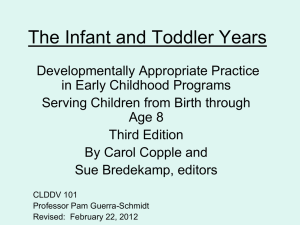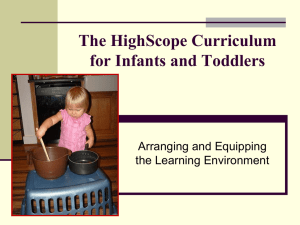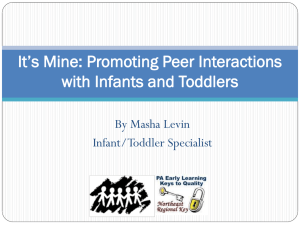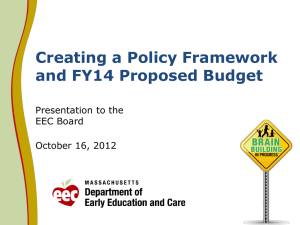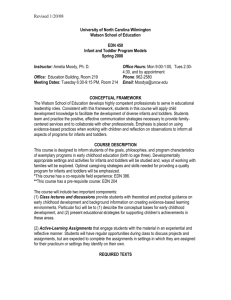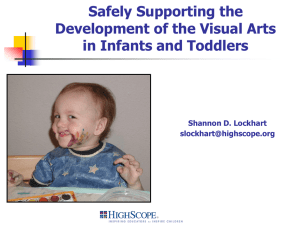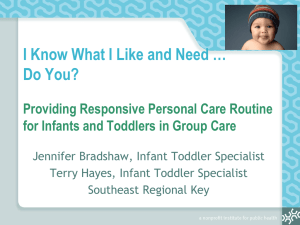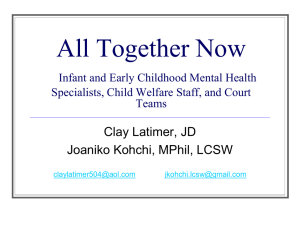Chapter 7 Infants and Toddlers
advertisement
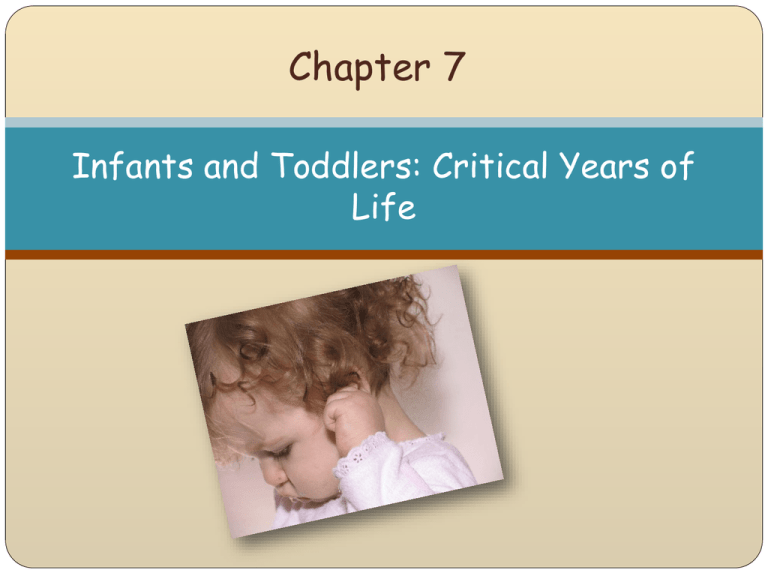
Chapter 7 Infants and Toddlers: Critical Years of Life Infants and Toddlers High quality care of infants and toddlers has become increasingly important, along with the increase in dual income families (i.e., families where both mothers and fathers work). The periods of infancy and toddlerhood are critical for learning, and we now understand that children at these ages are quite capable. This chapter focuses on the characteristics of infants and toddlers and the type of environments that support their learning and development. Upon completion of this chapter, you will be able to discuss the importance of developmentally appropriate practices and learning environments for the infant and toddler. Infancy and Toddlerhood Infant and Toddler Development Language and mobility leads to toddler independence and desire for autonomy. Teachers and caregivers must respond to infant and toddler developmental changes in ways that support their growth and development. Normal growth and development have been established, based on the mythical average child. Children will grow and develop at different rates. Teachers and caregivers should take into consideration children’s culture and family background when determining what is normal for the individual child. Nature and Nurture Discussions of whether nature (genetics) or nuture (environment) have more influence on development have shifted so that these two influences are no longer pitted against each other. Current thinking is that both are necessary to understand children's development and that the interaction between nature and nurture contributes to the individuality of children. versus plus Child’s Development Brain Development Decisions about early childhood programs and the organization of environments to promote child development rely on information gleaned from brain research. Brain research points to: the importance of early experiences; benefits of early intervention. Brain research provides information about stimulation, and development of specific areas of the brain. More on the Brain The child’s brain is anatomically like the adults brain, except that the adult’s brain weighs 3 pounds while the child’s brain is as follows: At birth – 14 ounces Six months– 1.31 pounds Three years – 2.4 pounds Ten years – 3 pounds More on the Brain Neurons are nerve cells which form synapses or connections through a process called synaptogenesis. Synaptogenesis continues until age 10. Brain connections are made when caretakers interact or play with, and respond and talk to young children. Connections that are used repeatedly become permanent. Neural shearing takes place when brain connections wither away due to lack of use. Influences on Development and Learning High quality • High quality experiences contribute to neural experiences connections. Critical periods • Experiences must occur at the right times Sensitive periods • Some things are learned easier during certain periods. Psychosocial Development Infants and toddlers fall within the trust vs. mistrust stage of Erickson’s theory of psychosocial development. Raised in environments of love, warmth, and support Environment with limited conflict between infant and parent or caregiver Children from birth to age two develop trust in others and themselves Caregivers are trustworthy and are sensitive to the child’s needs. Social Behaviors Infants use social behaviors to begin and maintain relationships. Infants interact socially with others by Crying Imitating and mimicking observed behaviors Bonding and Attachments Social and emotional relationships are influenced by bonding and attachments Bonding takes place between infant and parent begins at birth serves as the basis for mutual attachment Attachment enduring emotional tie between infant and parent children engage attachment behaviors (e.g., crying, sucking, babbling, etc.) to get and maintain proximity adults also engage in attachment behaviors (e.g., kissing, touching, embracing, etc.) to establish attachments Attachments Young children are capable of developing multiple attachments at the same time—although they may show a preference for the primary caregivers. High quality childcare programs seek out ways to ensure that mothers maintain primary attachments with their infants. The quality of parent-child attachments can me measured by the Strange Situation. This observational tool assesses whether or not an infant is securely attached to a caregiver. Temperament and Personality A child’s temperament is represented by his/her collective behavioral characteristics. A child’s temperament helps to determine their personality. Three Types of Children See Figure 7.3 for details about each type. Principles of Motor Development Motor development is sequential. Growth precedes from: Gross (large) behaviors Fine (small) behaviors Head (cephalo) Cephalocaudal Development Foot (caudal) Proximal (center of body) Proximodistal Development Distal (extremities) Cognitive Development Infants are toddler fit within Piaget’s sensorimotor stage, which is the first stage of cognitive development. Highlights of this stage include: initial learning through reflexive motor action; development of object permanence where the infant understands that objects they cannot see still exist; toddlers’ experimentation with objects to solve problems; thinking using mental images and memory; symbolic play where an unrelated object is used to represent another object (e.g., a stick is used to represent an airplane). Theories of Language Development Language acquisition is innate. All children learn language regardless of culture. Speech production develops according to innate biological schedules. The content of language is acquired in the environment through modeling. Social interactions are necessary for language development. . Environmental Theory Maturationist Theory Language Development Language Development First words Holophrastic speech (single word sentences) Symbolic representation (a word can stand for a mental image) Vocabulary development ( 50 words by age 2) Telegraphic speech (two word sentences) Language Development Additional important points about language development. . . Motherese – the way mothers and caregivers adapt their speech when talking to young children. Language patterns – children develop and master most language pattern by the end of preschool. The early years represent the sensitive period for learning language. Baby signing – infants as young as five months can learn signals that stand for something else. A growing movement suggests children should be taught to communicate using signs before they are able to talk. Developmentally Appropriate Programs Dimensions of Developmentally Appropriate Programs Developmentally appropriate programs consider: what is known about child development and learning; what is known about the strengths, interest, and needs of the individual child so that the program can adapt and be responsive to those interests and needs; the social and cultural context in which the child lives so that learning experiences can be meaningful, relevant, and respectful to children and their families. Developmentally Appropriate Programs Care must also be taken when matching teachers and child care providers with children of different ages. Certain teachers/child care providers will be more emotionally and professionally suited for certain ages of children. Environments to Support Infant and Toddler Development Environments to Support Infant and Toddler Development Teachers and childcare providers can organize environments that provide for: Heath and safety Support development of basic trust and autonomy Space and materials that encourage active involvement Infant and Toddler Curriculum The curriculum should provide for the child’s physical, social, emotional, cognitive, and linguistic development. The curriculum should be based on responsive relationships which means that it will respond to the needs and interests of the infant or toddler. The curriculum should include a daily routine encourage language development promote social development and interactions include engaging and challenging activities Infant and Toddler Mental Health Infant mental health refers to the overall health and well-being of young children in their family, community, and school relationships. Threats to children such as abuse, neglect, poverty, malnutrition, and the lack of loving relationships result in poor mental health. Poor mental health leads to negative outcomes such as: impaired mental functioning poor school achievement poor physical health substance abuse delinquency loss of human potential Infant and Toddler Mental Health Relations are important to mental health. Listed below are relational guidelines. individualize attention to the needs of both infants/toddlers and their parents. emphasis on the strengths of infants and toddlers. provide continuous and stable caregiving. be accessible to infants/toddlers and their parents. be culturally responsive by recognizing the values, beliefs, and practices of diverse cultures Diverse Learners All families should be welcomed. Families differ in terms of race, socioeconomic status, religion, and culture. See pg. 199 for tips on working with diverse families. Children today come from diverse family backgrounds. Collaborate with diverse families All families should feel valued. Culture influences beliefs about child rearing practices and family responsibilities. What’s next After reviewing this presentation and reading Chapter 7, Infants and Toddler: Critical Years for Learning, check your understanding of the terms and concepts listed below. You will then be ready to complete the Chapter 7 quiz. • • • • • • • • • • • • • Infant/toddler age range Nature vs. nurture Brain research and development Brain size-infant/toddler Neurons and synapses synaptogenesis neural shearing Critical periods Sensitive periods Experiences that support development of trust Social behavior Bonding and attachment Strange Situation Types of child temperaments Sequential motor development and growth • Cognitive development • Theories of language development • Stages of language development • Motherese • Development of language patterns • Using sign language • Dimensions of developmentally appropriated programs • Environments supportive of development • Infant/toddler curriculum • Infant/toddler mental health • Threats to mental health/outcomes • Relational guidelines to support mental health • Working with diversity


